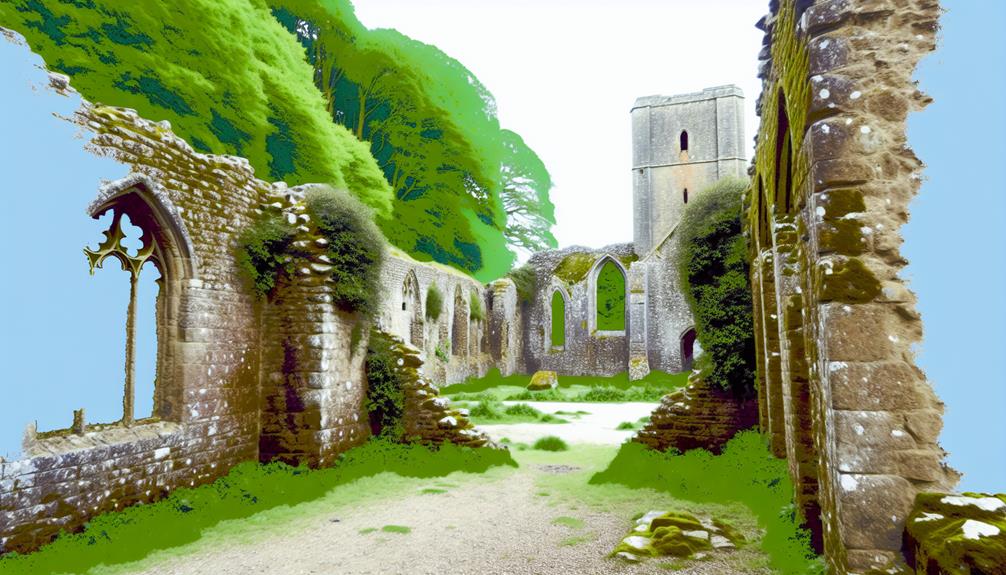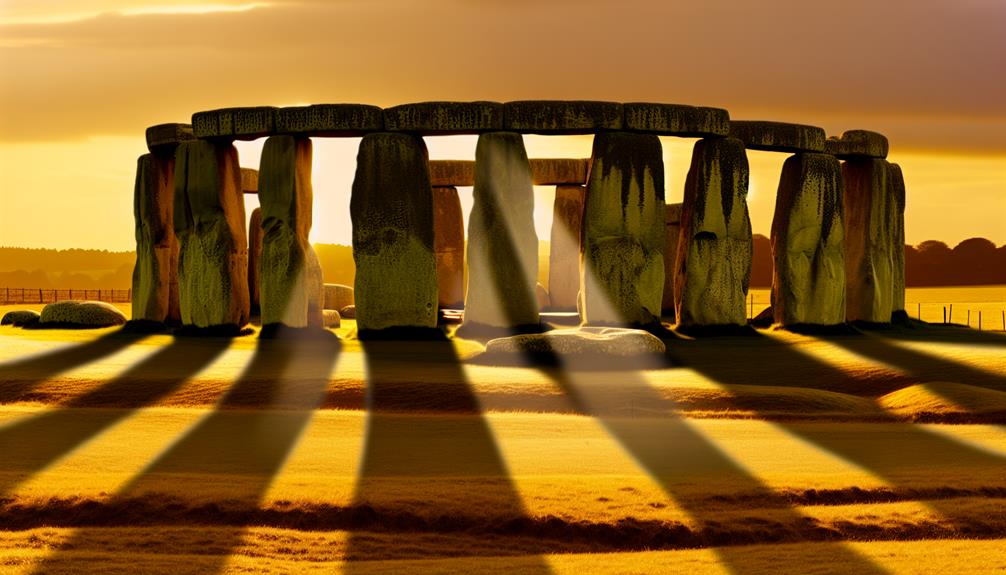Glastonbury Abbey, nestled in the picturesque landscape of the UK, serves as a beacon of history and spirituality intertwined. From its origins in the 8th century to the mysterious connections to King Arthur, this ancient site ignites curiosity and invites exploration. With its Gothic grandeur and tranquil gardens, Glastonbury Abbey stands as a testament to the enduring allure of the past. As we unravel the layers of time and legend within its walls, a journey of discovery awaits those who seek to uncover the secrets held within this hallowed ground.
Key Takeaways
- Founded in 712 AD by King Ine of Wessex.
- Legend of King Arthur linked to the abbey.
- Features Gothic architecture and medieval ruins.
- Spiritual pilgrimage site with serene ambiance.
- Hosts craft markets, showcasing local artisans.
History of Glastonbury Abbey
Glastonbury Abbey, located in Somerset, England, has a rich and storied history that dates back to the 7th century. Its Abbey origins trace back to the foundation by King Ine of Wessex around 712 AD. Initially dedicated to St. Mary, the abbey grew in prominence and wealth over the centuries, becoming one of the most important religious sites in England.
During the medieval period, Glastonbury Abbey flourished under the patronage of various English kings. It became a center of learning and spirituality, attracting scholars and pilgrims from far and wide. The abbey was renowned for its illuminated manuscripts and intricate carvings, showcasing the artistic talents of the medieval monks who resided there.
The medieval monks of Glastonbury Abbey lived a life of prayer, contemplation, and labor. They followed the Rule of St. Benedict, which emphasized the importance of ora et labora (prayer and work). The monks were responsible for maintaining the abbey grounds, copying manuscripts, and providing hospitality to travelers.
Through their dedication and hard work, the medieval monks contributed to the abbey's reputation as a place of great sanctity and learning. Their legacy lives on in the ruins of Glastonbury Abbey, which continue to attract visitors seeking to uncover the secrets of this ancient and revered site.
Legend of King Arthur
The legendary tale of King Arthur, a figure shrouded in myth and mystery, has been intricately intertwined with the history and folklore of Glastonbury Abbey. One of the most famous aspects of the Arthurian legend connected to Glastonbury is the story of Excalibur, King Arthur's magical sword. According to myths, Excalibur was said to have been given to Arthur by the Lady of the Lake, and its blade was imbued with extraordinary powers. The waters of the nearby Chalice Well are believed by some to be where Excalibur was returned upon King Arthur's death.
Camelot, the legendary castle and court associated with King Arthur, is another enigmatic element that has captured the imagination of many. While the exact location of Camelot remains a mystery, some theories suggest that Glastonbury may have been the site of this fabled place. The alleged connection between Glastonbury Abbey and Camelot has fueled speculation and intrigue for centuries, with researchers and enthusiasts seeking to uncover the truth behind the stories.
The legends of King Arthur, Excalibur, and Camelot continue to enchant visitors to Glastonbury Abbey, adding an aura of magic and mystique to the already spellbinding site. Whether rooted in historical fact or born from the imagination of storytellers, these tales contribute to the enduring appeal of Glastonbury Abbey as a place where reality and legend converge.
Architectural Features and Ruins
Architectural remnants and ruins at the site of Glastonbury Abbey showcase a rich tapestry of historical construction and design. The abbey, known for its Gothic architecture, features medieval ruins that captivate visitors with their intricate detailing and grandeur. The remnants of the abbey's past glory stand as a proof of the craftsmanship of the builders who constructed this magnificent structure.
The abbey's architectural features include towering walls, arched doorways, and intricately carved stone pillars, all characteristic of Gothic design. These elements transport visitors back in time to the medieval era, allowing them to envision the abbey in its prime. The ruins also provide valuable insights into the architectural techniques and styles prevalent during that period.
Over the years, archaeological discoveries at Glastonbury Abbey have shed light on its rich history and significance. Excavations have unearthed artifacts that offer clues about the daily life of the monks who once inhabited the abbey. Additionally, restoration projects have been undertaken to preserve the remaining structures and guarantee that future generations can continue to marvel at the abbey's architectural splendor.
Spiritual Significance and Pilgrimage
What spiritual significance does Glastonbury Abbey hold for pilgrims seeking a sacred journey?
Glastonbury Abbey, with its rich history and legendary associations, has long been revered as a place of spiritual significance and pilgrimage. For centuries, people from various faiths and backgrounds have been drawn to this sacred space in search of solace, reflection, and connection to something greater than themselves.
The abbey's mystical reputation is deeply rooted in its ties to religious history and folklore. Legend has it that Glastonbury Abbey is the burial place of King Arthur and Queen Guinevere, adding to its allure as a site of mystery and enchantment. This mythical connection has attracted countless pilgrims over the years, each seeking to experience the spiritual energies believed to permeate the grounds.
For many visitors, undertaking a spiritual journey to Glastonbury Abbey represents a quest for inner peace, healing, and enlightenment. The serene beauty of the abbey ruins, coupled with the tranquil ambiance of the surrounding landscape, creates an atmosphere conducive to contemplation and meditation. Whether seeking answers to life's deepest questions or simply a moment of respite from the chaos of the world, pilgrims find solace in the sacred space that Glastonbury Abbey provides.
Gardens and Grounds Overview
Amidst the historical ruins of Glastonbury Abbey, the meticulously tended gardens and expansive grounds offer a serene retreat for visitors seeking tranquility and connection with nature.
The gardens at Glastonbury Abbey are not just any ordinary green spaces; they are a tapestry of botanical wonders and hidden treasures waiting to be discovered.
Throughout the seasons, the abbey's gardens come alive with an array of seasonal blooms, each adding its own touch of color and fragrance to the landscape. From vibrant spring bulbs to the rich hues of autumn foliage, there is always something new and enchanting to behold. Serene pathways meander through the gardens, inviting visitors to wander and explore at their own pace, soaking in the beauty and peaceful ambiance that surrounds them.
The grounds of Glastonbury Abbey are designed to be both aesthetically pleasing and spiritually uplifting, providing a harmonious setting for reflection and contemplation. The careful attention to detail in the garden's layout and maintenance ensures that every corner holds a new delight, from secluded benches perfect for quiet reflection to open spaces ideal for group gatherings or picnics.
Visitors to Glastonbury Abbey's gardens can expect to be enchanted by the beauty of nature and find solace in the tranquility of their surroundings. Whether seeking a moment of peace or simply appreciating the artistry of the landscape, the gardens and grounds of Glastonbury Abbey offer a truly immersive experience for all who wander through them.
Events and Festivals at the Abbey
The vibrant tapestry of Glastonbury Abbey's gardens and grounds extends beyond its natural beauty to encompass a diverse array of events and festivals that enrich the visitor experience and celebrate the abbey's cultural heritage.
Throughout the year, Glastonbury Abbey hosts an exciting lineup of events and festivals that cater to a wide range of interests. Music concerts featuring both local talents and renowned artists grace the abbey's grounds, filling the air with melodies that resonate with the spirituality of the site. Workshops on various topics, from traditional crafts to mindfulness practices, offer visitors the chance to engage with the abbey's heritage in a hands-on and immersive way.
In addition to musical performances and workshops, craft markets at the abbey provide a platform for local artisans to showcase their talents and offer visitors unique and handmade treasures. The markets are vibrant hubs of creativity, where visitors can find one-of-a-kind souvenirs to take home. Food stalls dotted around the abbey grounds offer a culinary journey, with a variety of delicious treats to savor while exploring the abbey's beauty.
These events and festivals not only add to the ambiance of Glastonbury Abbey but also serve as platforms for cultural exchange and community engagement. They embody the spirit of freedom and creativity that is synonymous with Glastonbury, making each visit to the abbey a truly enriching experience.
Visitor Information and Tickets
Upon arrival at Glastonbury Abbey, visitors can access essential information regarding tickets and visitor services to enhance their exploration of this historic site. The visitor information center offers detailed information to guarantee a smooth and enjoyable visit. Here are some key points to note:
- Ticket Prices: Admission prices vary depending on the type of ticket and visitor category. Standard adult tickets are priced at £15, while seniors and students can avail discounted tickets at £12. Children under 16 can enter for free, making it a family-friendly destination. Special group rates are available for organized tours or educational visits.
- Opening Hours: Glastonbury Abbey is open to visitors throughout the year, with seasonal variations in operating hours. During the summer months (April to September), the Abbey welcomes visitors from 9:00 am to 6:00 pm daily. In the winter season (October to March), the opening hours are slightly shorter, from 9:00 am to 4:00 pm, providing ample time for exploration and appreciation of the site's beauty.
- Guided Tours: Visitors can opt for guided tours led by knowledgeable guides who provide insights into the Abbey's history and significance. These tours are included in the ticket price and offer a more detailed understanding of the site.
- Visitor Services: The Abbey offers facilities such as a gift shop, café, and restrooms to cater to the needs of visitors, ensuring a comfortable and enriching experience during their visit.
Conservation Efforts and Future Plans
In the domain of historical preservation at Glastonbury Abbey, a thorough approach to conservation efforts and strategic future plans is crucial. Sustainability initiatives play a central role in guaranteeing that the abbey's rich heritage is preserved for generations to come. The implementation of sustainable practices, such as energy-efficient lighting, recycling programs, and water conservation measures, not only reduces the environmental impact but also helps to maintain the structural integrity of the abbey.
Community engagement is another key aspect of the conservation efforts at Glastonbury Abbey. By involving the local community in restoration projects, educational programs, and volunteer opportunities, the abbey fosters a sense of ownership and pride among residents and visitors alike. This engagement not only provides valuable support for ongoing conservation work but also helps to raise awareness about the importance of preserving historical sites for future enjoyment.
Looking ahead, Glastonbury Abbey has ambitious future plans to further enhance its conservation efforts. This includes expanding sustainability initiatives to reduce carbon emissions, implementing innovative technologies for preservation, and collaborating with experts in the field to ensure best practices are followed. By staying dedicated to conservation and actively involving the community, Glastonbury Abbey is poised to continue its legacy as a beacon of history and heritage in the UK.
Frequently Asked Questions
Can Visitors Participate in Archaeological Digs at Glastonbury Abbey?
Excavation opportunities at historical sites often include volunteer programs that allow visitors to actively engage in uncovering artifacts and contributing to the field of archaeology. These programs offer participants a hands-on experience in the excavation process under the guidance of trained professionals.
Are There Any Ghost Stories or Paranormal Encounters Reported at the Abbey?
Haunted tales and supernatural encounters are often a subject of intrigue and fascination among visitors to historical sites. Mysterious happenings and eerie sightings can add an air of mystique to the atmosphere, sparking curiosity and speculation.
These reports, whether rooted in folklore or personal experiences, contribute to the allure of such locations, inviting exploration and contemplation of the unknown.
Is There a Gift Shop On-Site Selling Unique Abbey Souvenirs?
Yes, there is a gift shop on-site at the abbey offering a wide range of unique and special memorabilia. The gift shop showcases handmade crafts created by local artisans, providing visitors with an opportunity to purchase one-of-a-kind items that reflect the history and essence of the abbey.
These souvenirs offer a tangible connection to the site and serve as mementos for those exploring the abbey's rich heritage.
Are There Any Restrictions on Photography or Filming Within the Abbey?
When considering photography policy and filming regulations at historical sites, it is common for restrictions to be in place to safeguard the integrity of the location and guarantee the safety and privacy of visitors.
For example, some sites may prohibit flash photography to preserve delicate artifacts or limit filming in certain areas to maintain a peaceful atmosphere for reflection.
Understanding and respecting these guidelines is essential for all visitors to contribute to the preservation of these cultural treasures.
Can Visitors Attend Special Ceremonies or Services at the Abbey?
Visitors to religious sites often seek opportunities to participate in special ceremonies or services, fostering a deeper spiritual connection.
Abbey events offer a chance for visitor involvement in ceremonial traditions, enriching their experience. Witnessing or partaking in these spiritual services can provide a profound sense of community and reverence, enhancing the visit's significance.
The inclusion of visitors in such sacred rituals can contribute to a more immersive and memorable encounter with the religious heritage of the abbey.
Conclusion
In the tapestry of time, Glastonbury Abbey stands as a beacon of history, legend, and spirituality. Like a precious gem unearthed from the depths of the earth, its Gothic architecture, medieval ruins, and serene gardens captivate all who walk its hallowed grounds.
As pilgrims and visitors alike seek solace and inspiration within its walls, the Abbey continues to weave tales of a bygone era, inviting us to explore the mysteries of the past and contemplate the wonders of the present.


